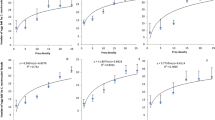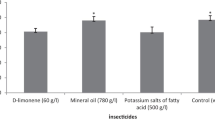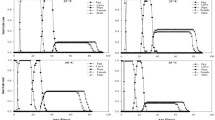Abstract
Assessments of compatibility between targeted insecticides and beneficial organisms are important for integrated pest management programs. In this study, we investigated the effect of some biorational insecticides: D-limonene (applied at 1 g/L), mineral oil (applied at 20 g/L), potassium salts of fatty acid (applied at 0.4 g/L), pyriproxyfen (applied at 0.25 g/L), and potassium salts of fatty acid (C7-C18) (applied at 3 g/L) on the functional response of Cryptolaemus montrouzieri (Mulsant) feeding on Dactylopius opuntiae (Cockerell) females under controlled conditions (26 °C). Previous experiments established that the insecticide rates used in the present study were sublethal, as they did not cause short-term mortality to the predator. In the absence of insecticides, the predator exhibited a type II functional response. All insecticide treatments in this study did not hamper the ladybird functional response, but it altered the shape of the curve compared to the control (tap water). Our results showed that all insecticides treatments residues do not have lethal effects on C. montrouzieri adult, and do not affect significantly his predation. Pyriproxyfen and potassium salts of fatty acid (C7-C18) seem to be the least compatible with C. montrouzieri as it led to both a significant reduction of attack rate (0.01–0.05) and an increase in handling time (2.57–12.77 h). In contrast D-limonene (applied at 1 g/L), mineral oil (applied at 20 g/L) were the most compatible with the predator, as it led to both a significant increase in attack rate (0.05–0.12) and a decrease in handling time (3.91- 5.71 h).

Similar content being viewed by others
References
Agnello A (2002) Petroleum-derived spray oils: chemistry, history, refining and formulation. In: Beattie GAC, Watson DM, Stevens ML, Rae DJ, Spooner-Hart RN (eds) Spray oils beyond 2000. University of Western Sydney, Sydney, pp 2–18
Anjitha A, Krishnamoorthy SV, Kuttalam S (2013) Toxicity of insecticides to the coccinellid predators, Cryptolaemus montrouzieri Mulsant and Scymnus coccivora Ayyar of papaya mealybug, Paracoccus marginatus Williams and Granara de Willink. J Bio Control 27(1):18–23
Ambrose DP, Rajan SJ, Raja JM (2010) Impacts of Synergy-505 on the functional response and behavior of the reduviid bug. Rhynocoris Marginatus j Insect Sci 10:187. https://doi.org/10.1673/031.010.18701
Barbosa PRR, Oliveira MD, Giorgi JA, Silva-Torres CSA, Torres JB (2014) Predatory behavior and life history of Tenuisvalvae notata (coleoptera: coccinellidae) under variable prey availability conditions. Fla Entomol 97:1026–1034. https://doi.org/10.1653/024.097.0304
Bouharroud R, Sbaghi M, Boujghagh M, El Bouhssini M (2018) Biological control of the prickly pear cochineal Dactylopius opuntiae Cockerell (Hemiptera: Dactylopiidae). EPPO Bulletin 48:300–306. https://doi.org/10.1111/epp.12471
Brennan TCR, Kromer JO, Nielsen LK (2013) Physiological and transcriptional responses of Saccharomyces cerevisiae to d-limonene show changes to the cell wall but not to the plasma membrane. Appl Environ Microbiol 79:3590–3600. https://doi.org/10.1128/AEM.00463-13
Candolfi MP, Barrett KL, Campbell P, Forster R, Grandy N, Huet MC (2001) Guidance document on regulatory testing and risk assessment procedures for plant protection products with non-target arthropods. European Standard Characteristics of Regulatory Testing (ESCORT 2) Workshop. Wageningen, The Netherlands: SETAC Europe, pp. 21–23.
Castro RM (2011) Biologia e exigências térmicas de Zagreus bimaculosus (Mulsant) (Coleoptera: Coccinellidae). Recife: UFRPE (Dissertação de Mestrado).
Carver RH, Nash JG (2011) Doing data analysis with SPSS: version 18.0. Cengage Learning (U.S).
Chong JH, Oetting RD (2006) Functional response and progeny production of the Madeira mealybug parasitoid, Anagyrus sp. nov. nr. sinope: the effects of host and parasitoid densities. Biol Control 39:320–328. https://doi.org/10.1016/j.biocontrol.2006.08.013
Collins MD, Wards S, Dixon AFG (1981) Handling time and the functional response of Aphelinus thomsoni, a predator and parasite of the aphid Drepanosiphum platanoides. J Anim Ecol 50:479–489. https://doi.org/10.2307/4069
Cranshaw WS, Baxendale B (2011) Insect Control: Horticultural Oils. Colorado State Univirsity, http://www.ext.colostate.edu/pubs/insect/05569.html
El Aalaoui M, Bouharroud R, Sbaghi M, El Bouhssini M, Hilali L (2019a) Predatory potential of eleven native Moroccan adult ladybird species on different stages of Dactylopius opuntiae (Cockerell) (Hemiptera: Dactylopiidae). EPPO Bulletin 49(2):374–379. https://doi.org/10.1111/epp.12565
El-Aalaoui M, Bouharroud R, Sbaghi M, El Bouhssini M, Hilali L (2019b) First study of the biology of Cryptolaemus montrouzieri and its potential to feed on the mealybug Dactylopius opuntiae (Hemiptera: Dactylopiidae) under laboratory conditions in Morocco. Arch Phytopathology Plant Protect 52(13–14):1112–1124. https://doi.org/10.1080/03235408.2019.1691904
El Aalaoui M, Bouharroud R, Sbaghi M, El Bouhssini M, Hilali L, Dari K (2019c) Comparative toxicity of different chemical and biological insecticides against the scale insect Dactylopius opuntiae and their side effects on the predator Cryptolaemus montrouzieri. Arch Phytopathology Plant Protect 52(1–2):155–169. https://doi.org/10.1080/03235408.2019.1589909
El Aalaoui M, Sbaghi M, Bouharroud R, El Bouhssini M, Hilali L (2020) Hyperpredation of local adults ladybirds on the eggs of Cryptolaemus montrouzieri a potential predator of carmine cactus cochineal Dactylopius opuntiae in Morocco Int J Trop Insect Sci 1–6 https://doi.org/10.1007/s42690-020-00282-w
El Aalaoui M, El Bouhssini M, Bouharroud R, Sbaghi M (2021) Lethal and sublethal effects of the insecticides d-limonene, mineral oil, and potassium salts of fatty acid on Dactylopius Opuntiae potential predator Cryptolaemus Montrouzieri Int J Trop Insect Sci 1–10 https://doi.org/10.1007/s42690-021-00473-z
Elliott JM (2003) A comparative study of the functional response of four species of carnivorous stoneflies. Freshw Biol 48(2):191–202. https://doi.org/10.1046/j.1365-2427.2003.00982.x
Fernandez DE, Beers EH, Brunner JF, Doerr ME, Dunley JE (2001) Mineral oil inhibition of white apple leafhopper (Homoptera: Cicadellidae) oviposition. J Entomol Sci 36(3): 237–243. https://doi.org/10.18474/0749-8004-36.3.237
Fernández-Arhex V, Corley JC (2004) La respuesta funcional: una revisión y guía experimental. Ecol Austral 14(1):83–93
Flores A, Olvera H, Rodríguez S, Barranco J (2013) Predation potential of Chilocorus cacti (Coleoptera: Coccinellidae) to the prickly pear cacti pest Dactylopius opuntiae (Hemiptera: Dactylopiidae). Neotrop Entomol 42(4):407–411. https://doi.org/10.1007/s13744-013-0139-z
Giorgi JA, Barbosa PRR, Oliveira JEM, Torres JB (2017) Prodiloides bipunctata Weise (Coccinellidae: Cephaloscymnini): new research on native natural predators of the carmine cochineal, Dactylopius opuntiae (Cockerel) (Hemiptera: Dactylopiidae) in the Brazilian Semi-arid. The Coleopterist Bulletin (in press).
Halappa B, Awaknavar JS, Archana D, Bandi S, Kumar GSA (2013) Laboratory evaluation of insecticides against Australian beetle, Cryptolaemus montrouzieri Mulsant (Coccinellidae: Coleoptera). Current Biotica 7(3):196–201
Hassell MP, Lawton JH, Beddington JR (1977) Sigmoid functional responses by invertebrate predators and parasitoids J Anim Ecol 249–262 https://doi.org/10.2307/3959
Helmy EI, Kwaiz FA, El-Sahn OMN (2012) The usage of mineral oils to control insects. Egypt Acad J Biol Sci : Entomol 5(3):167–174
He Y, Zhao J, Zheng Y, Desneux N, Wu K (2012) Lethal effect of imidacloprid on the coccinellid predator Serangium japonicum and sublethal effects on predator voracity and on functional response to the whitefly Bemisia tabaci. Ecotoxicol 21(5):1291–1300. https://doi.org/10.1007/s10646-012-0883-6
Hodek I, Honek A (1996) Ecology of Coccinellidae. Kluwer Academic Publishers, Dordrecht, Boston, London, p 464
Holling CS (1959) Some characteristics of simple types of predation and parasitism. Can Entomol 91(7):385–398
Juliano SA (2001) Non-linear curve fitting: predation and functional response curves. In: Scheiner SM, Gurevitch J (eds) Design and analysis of ecological experiments, 2nd edn. Chapman and Hall, New York, pp 178–196
Juliano SA, Williams FM (1987) A comparison of methods for estimating the functional response parameters of the random predator equation. J Anim Ecol 52(2):641–653. https://doi.org/10.2307/5074
Karr LL (1989) Toxic properties of d-limonene in insects and the earthworm Eisenia fetida. Dissertations, University of Iowa, Ames, IA (US).
Khan HAA, Sayyed AH, Akram W, Razald S, Ali M (2012) Predatory potential of Chrysoperla carnea and Cryptolaemus montrouzieri larvae on different stages of the mealybug, Phenacoccus solenopsis: A threat to cotton in South Asia. J Insect Sci 12(1):147. https://doi.org/10.1673/031.012.14701
Kim M, Shin D, Suh E, Cho K (2004) An assessment of the chronic toxicity of fenpyroximate and pyridaben to Tetranychus urticae using a demographic bioassay. Appl Entomol Zool 39(3):401–409. https://doi.org/10.1303/aez.2004.401
Li DX, Tian J, Shen ZR (2006) Effects of pesticides on the functional response of predatory thrips, Scolothrips takahashii to Tetranychus viennensis. J Appl Entomol 130(5):314–322. https://doi.org/10.1111/j.1439-0418.2006.01056.x
Lima MS, da Silva DMP, Falcão HM, Ferreira WM, Silva LD, Paranhos BAJ (2011) Predators of the Dactylopius opuntiae (Hemiptera: Dactylopiidae) on fodder opuntia in the Pernambuco State, Brazil. Rev Chil Entomol 36:51–54
Malaquias JB, Ramalho FS, Omoto C, Godoy WAC, Silveira RF (2014) Imidacloprid affects the functional response of predator Podisus nigrispinus (Dallas)(Heteroptera: Pentatomidae) to strains of Spodoptera frugiperda (JE Smith) on Bt cotton. Ecotoxicol 23(2):192–200. https://doi.org/10.1007/s10646-013-1162-x
Martinou AF, Raymond B, Milonas PG, Wright DJ (2010) Impact of intraguild predation on parasitoid foraging behaviour. Ecol Entomol 35(2):183–189. https://doi.org/10.1111/j.1365-2311.2009.01171.x
Martinou AF, Seraphides N, Stavrinides MC (2014) Lethal and behavioral effects of pesticides on the insect predator Macrolophus pygmaeus. Chemosphere 96:167–173. https://doi.org/10.1016/j.chemosphere.2013.10.024
Martinou AF, Stavrinides MC (2015) Effects of sublethal concentrations of insecticides on the functional response of two mirid generalist predators. PLoS ONE 10(12):e0144413. https://doi.org/10.1371/journal.pone.0144413
Murdoch WW, Briggs CJ, Nisbet RM (2003) Consumer-resource dynamics. Princeton University Press, Princeton, NJ
Murdoch WW, Oaten A (1975) Predation and population stability. Adv Ecol Res 9:1–131. https://doi.org/10.1016/S0065-2504(08)60288-3
Murray GP, Stillman RA, Gozlan RE, Britton JR (2013) Experimental predictions of the functional response of a freshwater fish. Ethol 119(9):751–761. https://doi.org/10.1111/eth.12117
Nawaz M, Cai W, Jing Z, Zhou X, Mabubu JI, Hua H (2017) Toxicity and sublethal effects of chlorantraniliprole on the development and fecundity of a non-specific predator, the multicolored Asian lady beetle, Harmonia axyridis (Pallas). Chemosphere 178:496–503. https://doi.org/10.1016/j.chemosphere.2017.03.082
Osborne LS, Petitt FL (1985) Insecticidal soap and the predatory mite, Phytoseiulus persimilis (Acari: Phytoseiidae), used in management of the twospotted spider mite (Acari: Tetranychidae) on greenhouse grown foliage plants. J Econ Entomol 78(3):687–691. https://doi.org/10.1093/jee/78.3.687
Pasini C, D'Aquila F, Curir P, Gullino ML (1997) Effectiveness of antifungal compounds against rose powdery mildew (Sphaerotheca pannosa var. rosae) in glasshouses. Crop Prot 16(3): 251–256. https://doi.org/https://doi.org/10.1016/S0261-2194(96)00095-6
Pervez A, Omkar, (2005) Functional responses of coccinellid predators: an illustration of a logistic approach. J Insect Sci 5(5):1–6. https://doi.org/10.1093/jis/5.1.5
Planes L, Catalán J, Tena A, Porcuna JL, Jacas JA, Izquierdo J, Urbaneja A (2013) Lethal and sublethal effects of spirotetramat on the mealybug destroyer. Cryptolaemus Montrouzieri J Pest Sci 86(2):321–327. https://doi.org/10.1007/s10340-012-0440-3
Prats D, Rodrguez M, Varo P, Moreno A, Ferrer J, Berna JL (1999) Biodegradation of soap in anaerobic digesters and on sludge amended soils. Water Res 33(1):105–108. https://doi.org/10.1016/S0043-1354(98)00199-7
Protasov A, Mendel Z, Spodek M, Carvalho CJ (2017) Management of the Opuntia cochineal scale insect, Dactylopius opuntiae (Cockerell) in Israel. Alon Hanotea 71:48–51
Riedl H, Halaj J, Kreowski WB, Hilton RJ, Westigard PH (1995) Laboratory evaluation of mineral oils for control of codling moth (Lepidoptera: Tortricidae). J Econ Entomol 88(1):140–147. https://doi.org/10.1093/jee/88.1.140
Rill SM, Grafton-Cardwell EE, Morse JG (2008) Effects of two insect growth regulators and a neonicotinoid on various life stages of Aphytis melinus (Hymenoptera: Aphelinidae). Biocontrol 53(4):579–587. https://doi.org/10.1007/s10526-007-9097-x
Rimoldi F, Schneider MI, Ronco AE (2008) Susceptibility of Chrysoperla externa eggs (Neuroptera: Chrisopidae) to conventional and biorational insecticides. Environ Entomol 37(5):1252–1257. https://doi.org/10.1093/ee/37.5.1252
Rimoldi F, Fogel MN, Ronco AE, Schneider MI (2017) Comparative susceptibility of two Neotropical predators, Eriopis connexa and Chrysoperla externa, to acetamiprid and pyriproxyfen: short and long-term effects after egg exposure. Environ Pollut 231:1042–1050. https://doi.org/10.1016/j.envpol.2017.08.097
Rogers D (1972) Random search and insect population models. J Anim Ecol 41:369–383. https://doi.org/10.2307/3474
Sanches NF, Carvalho RS (2010) Procedimentos para manejo da criação e multiplicação do predador exótico Cryptolaemus montrouzieri. Cruz dasAlmas: BrasilEmbrapa Mandioca e Fruticultura (Circular Técnica, 99).
Seo G, DeAngelis DL (2011) A predator–prey model with a Holling type I functional response including a predator mutual interference. J Nonlinear Sci 21(6):811–833. https://doi.org/10.1007/s00332-011-9101-6
Smith EH, Pearce GW (1948) The mode of action of petroleum oils as ovicides. J Econ Entomol 41(2):173–180. https://doi.org/10.1093/jee/41.2.173
Solomon ME (1949) The natural control of animal populations. J Anim Ecol 18:1–35. https://doi.org/10.2307/1578
Sullivan JJ, Goh KS (2008) Environmental fate and properties of pyriproxyfen. J Pestic Sci 33(4):339–350. https://doi.org/10.1584/jpestics.R08-02
Taylor WE, Vickery B (1974) Insecticidal properties of limonene, a constituent of citrus oil. Ghana J Agric Sci 7:61–62
Trexler JC, McCulloch CE, Travis J (1988) How can the functional response best be determined? Oecologia 76(2):206–214
Tsolakis H, Ragusa S (2008) Effects of a mixture of vegetable and essential oils and fatty acid potassium salts on Tetranychus urticae and Phytoseiulus persimilis. Ecotoxicol Environ Saf 70(2):276–282. https://doi.org/10.1016/j.ecoenv.2007.10.001
Vanegas-Rico JM, Lomeli-Flores JR, Rodríguez-Leyva E, Mora-Aguilera G, Valdez JM (2010) Enemigos naturales de Dactylopius opuntiae (Cockerell) en Opuntia ficus-indica (L.) Miller en el centro de México. Acta Zool Mex 26(2): 415–433.
Wanumen AC, Sánchez-Ramos I, Viñuela E, Medina P, Adán Á (2016) Impact of feeding on contaminated prey on the life parameters of Nesidiocoris tenuis (Hemiptera: Miridae) adults. J Insect Sci 16(1). https://doi.org/10.1093/jisesa/iew084
Wiedenmann RN, O’Neil RJ (1991) Laboratory measurement of the functional response of Podisus maculiventris (Say) (Heteroptera: Pentatomidae). Environ Entomol 20(2):610–614. https://doi.org/10.1093/ee/20.2.610
Wins-Purdy AH, Whitehouse C, Judd GJR, Evenden ML (2009) Effect of horticultural oil on oviposition behavior and egg survival in the obliquebanded leafroller (Lepidoptera: Tortricidae). Can Entomol 141(1):86–94. https://doi.org/10.4039/n08-042
Xiao D, Zhao J, Guo X, Chen H, Qu M, Zhai W, Desneux N, Biondi A, Zhang F, Wang S (2016) Sublethal effects of imidacloprid on the predatory seven-spot ladybird beetle Coccinella septempunctata. Ecotoxicol 25(10):1782–1793. https://doi.org/10.1007/s10646-016-1721-z
Zwick RW, Westigard PH (1978) Prebloom petroleum oil applications for delaying pear psylla (Homoptera: Psyllidae) oviposition. Can. Entomol 110(3): 225–236. https://doi.org/10.4039/Ent110225-3
Funding
The research of this study was supported by the National Institute of Agronomic Research (INRA), Morocco.
Author information
Authors and Affiliations
Corresponding author
Ethics declarations
Conflict of Interest
The authors declare that they have no conflict of interests.
Ethical approval
This article does not contain any studies with human participants or animals performed by any of the authors.
Additional information
Publisher's Note
Springer Nature remains neutral with regard to jurisdictional claims in published maps and institutional affiliations.
Rights and permissions
About this article
Cite this article
Aalaoui, M.E., Sbaghi, M. Effects of sublethal concentrations of some biorational insecticides in predation potential of Cryptolaemus montrouzieri on Dactylopius opuntiae. Int J Trop Insect Sci 42, 519–526 (2022). https://doi.org/10.1007/s42690-021-00567-8
Received:
Accepted:
Published:
Issue Date:
DOI: https://doi.org/10.1007/s42690-021-00567-8




